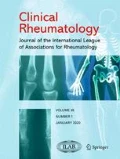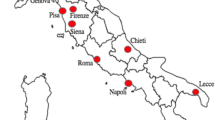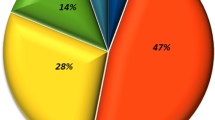Abstract
Objective
The aim of the present study is to investigate the clinical features of patients with Behcet’s disease (BD) in Mongolia.
Methods
Patients were identified and examined from six medical institutions in Mongolia from January 2015 to January 2019. BD was diagnosed according to the diagnostic criteria for BD established by the International Study Group.
Results
There were sixty-five patients (22 males and 43 females) recoded, the ratio of 1:1.95, with a marked female predominance. The age of disease onset was 22.2 ± 10.0 (mean ± SD), ranging from 11 to 66 years old. Oral aphthous ulcers, ocular lesions, skin lesions, genital ulcers, pathergy test positivity, articular lesions, superficial vasculitis, deep vein thrombosis, and epididymitis (male only) were observed in 100.0%, 63.1%, 81.5%, 89.2%, 7.7%, 86.2%, 32.3%, 4.6%, and 13.6% of the patients, respectively. The incidence of poor visual prognosis, ≤ 20/200, was significantly higher in males than in females (31.8 vs. 9.3%, incidence rate ratio 4.55 (95% CI 1.16–17.82), p < 0.05). The pathergy test was positive only in 7.7% of cases and only in female subjects. Nasal mucous ulcers were frequently seen in 55.4% of patients that may also be attributed to the environmental conditions of Mongolia. Headache was observed 76.9% of patients in this study.
Conclusions
Clinical manifestations of BD in Mongolia are presented for the first time. The visual prognosis was significantly worse in males. Nasal mucous membrane ulcers and recurrent headaches were frequent among Mongolian patients with BD.
Key Points • First results of the examination of the clinical features of Behcet’s disease patients in Mongolia. • Nasal ulcerations and recurrent headaches are frequent symptoms in Mongolia Behcet’s disease patients, potentially attributed to climate. • Male Behcet’s disease patients in Mongolia have a significantly worse prognosis for eye-related complications and vision. |


Similar content being viewed by others
Data availability
All data generated or analyzed during this study are included in this published article and its supplementary information files.
References
Ohno S, Ohguchi M, Hirose S, Matsuda H, Wakisaka A, Aizawa M (1982) Close association of HLA-Bw51 with Behcet’s disease. Arch Ophthalmol 100(9):1455–1458
Ohno S, Aoki K, Sugiura S, Nakayama E, Itakura K, Aizawa M (1973) Letter: HL-A5 and Behcet’s disease. Lancet. 2(7842):1383–1384
Ohno S, Asanuma T, Sugiura S, Wakisaka A, Aizawa M, Itakura K (1978) HLA-Bw51 and Behcet’s disease. JAMA. 240(6):529
Maldini C, Lavalley MP, Cheminant M, de Menthon M, Mahr A (2012) Relationships of HLA-B51 or B5 genotype with Behcet’s disease clinical characteristics: systematic review and meta-analyses of observational studies. Rheumatology (Oxford) 51(5):887–900
Meguro A, Inoko H, Ota M, Katsuyama Y, Oka A, Okada E, Yamakawa R, Yuasa T, Fujioka T, Ohno S, Bahram S, Mizuki N (2010) Genetics of Behcet disease inside and outside the MHC. Ann Rheum Dis 69(4):747–754
Mizuki N, Meguro A, Ota M, Ohno S, Shiota T, Kawagoe T, Ito N, Kera J, Okada E, Yatsu K, Song YW, Lee EB, Kitaichi N, Namba K, Horie Y, Takeno M, Sugita S, Mochizuki M, Bahram S, Ishigatsubo Y, Inoko H (2010) Genome-wide association studies identify IL23R-IL12RB2 and IL10 as Behcet’s disease susceptibility loci. Nat Genet 42(8):703–706
Kirino Y, Bertsias G, Ishigatsubo Y, Mizuki N, Tugal-Tutkun I, Seyahi E et al (2013) Genome-wide association analysis identifies new susceptibility loci for Behcet’s disease and epistasis between HLA-B*51 and ERAP1. Nat Genet 45(2):202–207
Pehlivan M, Kurtuncu M, Tuzun E, Shugaiv E, Mutlu M, Eraksoy M et al (2011) The comparison of socio-economic conditions and personal hygiene habits of neuro-Behcet’s disease and multiple sclerosis patients. Int J Hyg Environ Health 214(4):335–337
Mumcu G, Niazi S, Stewart J, Hagi-Pavli E, Gokani B, Seoudi N et al (2009) Oral health and related quality of life status in patients from UK and Turkey: a comparative study in Behcet’s disease. J Oral Pathol Med 38(5):406–409
Aramaki K, Kikuchi H, Hirohata S (2007) HLA-B51 and cigarette smoking as risk factors for chronic progressive neurological manifestations in Behcet’s disease. Mod Rheumatol 17(1):81–82
Worden RL, Savada AM(1991) Library of Congress. Federal Research Division., Historical Evaluation and Research Organization. Mongolia: a country study. 2nd ed. Federal Research Division For sale by the Supt. of Docs., U.S. G.P.O., Washington, D.C.
(1990) Criteria for diagnosis of Behcet’s disease. International Study Group for Behcet’s Disease. Lancet 335(8697):1078–80
Bang DS, Oh SH, Lee KH, Lee ES, Lee SN (2003) Influence of sex on patients with Behcet’s disease in Korea. J Korean Med Sci 18(2):231–235
Zhang Z, He F, Shi Y (2013) Behcet’s disease seen in China: analysis of 334 cases. Rheumatol Int 33(3):645–648
Tursen U, Gurler A, Boyvat A (2003) Evaluation of clinical findings according to sex in 2313 Turkish patients with Behcet’s disease. Int J Dermatol 42(5):346–351
Lennikov A, Alekberova Z, Goloeva R, Kitaichi N, Denisov L, Namba K, Takeno M, Ishigatsubo Y, Mizuki N, Nasonov E, Ishida S, Ohno S (2015) Single center study on ethnic and clinical features of Behcet’s disease in Moscow, Russia. Clin Rheumatol 34(2):321–327
Ishido T, Horita N, Takeuchi M, Kawagoe T, Shibuya E, Yamane T et al (2017) Clinical manifestations of Behcet’s disease depending on sex and age: results from Japanese nationwide registration. Rheumatology (Oxford) 56(11):1918–1927
Sanghvi C, Aziz K, Jones NP (2004) Uveitis and the menstrual cycle. Eye (Lond) 18(5):451–454
Apaydin KC, Duranoglu Y, Ozgurel Y, Saka O (2000) Serum prolactin levels in Behcet’s disease. Jpn J Ophthalmol 44(4):442–445
Atasoy M, Karatay S, Yildirim K, Kadi M, Erdem T, Senel K (2006) The relationship between serum prolactin levels and disease activity in patients with Behcet’s disease. Cell Biochem Funct 24(4):353–356
Mont’Alverne AR, Yamakami LY, Goncalves CR, Baracat EC, Bonfa E, Silva CA (2015) Diminished ovarian reserve in Behcet’s disease patients. Clin Rheumatol 34(1):179–183
El Menyawi MM, Raslan HM, Edrees A (2009) Clinical features of Behcet’s disease in Egypt. Rheumatol Int 29(6):641–646
Ideguchi H, Suda A, Takeno M, Ueda A, Ohno S, Ishigatsubo Y (2011) Behcet disease: evolution of clinical manifestations. Medicine (Baltimore) 90(2):125–132
Maldini C, Druce K, Basu N, LaValley MP, Mahr A (2018) Exploring the variability in Behcet’s disease prevalence: a meta-analytical approach. Rheumatology (Oxford) 57(1):185–195
Ek L, Hedfors E (1993) Behcet’s disease: a review and a report of 12 cases from Sweden. Acta Derm Venereol 73(4):251–254
Kidd D (2003) The prevalence of Behcet’s syndrome and its neurological complications in Hertfordshire, U.K. Adv Exp Med Biol 528:95–97
Yu KH, See LC, Kuo CF, Chou IJ, Chou MJ (2013) Prevalence and incidence in patients with autoimmune rheumatic diseases: a nationwide population-based study in Taiwan. Arthritis Care Res (Hoboken) 65(2):244–250
Zouboulis CC, Kotter I, Djawari D, Kirch W, Kohl PK, Ochsendorf FR et al (1997) Epidemiological features of Adamantiades-Behcet’s disease in Germany and in Europe. Yonsei Med J 38(6):411–422
Kaburaki T, Araki F, Takamoto M, Okinaga K, Yoshida A, Numaga J et al (2010) Best-corrected visual acuity and frequency of ocular attacks during the initial 10 years in patients with Behcet’s disease. Graefes Arch Clin Exp Ophthalmol 248(5):709–714
Tugal-Tutkun I, Onal S, Altan-Yaycioglu R, Huseyin Altunbas H, Urgancioglu M (2004) Uveitis in Behcet disease: an analysis of 880 patients. Am J Ophthalmol 138(3):373–380
Mishima S, Masuda K, Izawa Y, Mochizuki M, Namba K (1979) The eighth Frederick H. Verhoeff lecture. presented by Saiichi Mishima, MD Behcet’s disease in Japan: ophthalmologic aspects. Trans Am Ophthalmol Soc 77:225–279
Colvard DM, Robertson DM, O’Duffy JD (1977) The ocular manifestations of Behcet’s disease. Arch Ophthalmol 95(10):1813–1817
Atmaca LS (1989) Fundus changes associated with Behcet’s disease. Graefes Arch Clin Exp Ophthalmol 227(4):340–344
Barra C, Belfort Junior R, Abreu MT, Kim MK, Martins MC, Petrilli AM (1991) Behcet’s disease in Brazil--a review of 49 cases with emphasis on ophthalmic manifestations. Jpn J Ophthalmol 35(3):339–346
Demiroglu H, Barista I, Dundar S (1997) Risk factor assessment and prognosis of eye involvement in Behcet’s disease in Turkey. Ophthalmology. 104(4):701–705
Ozdal PC, Ortac S, Taskintuna I, Firat E (2002) Posterior segment involvement in ocular Behcet’s disease. Eur J Ophthalmol 12(5):424–431
Ambresin A, Tran T, Spertini F, Herbort C (2002) Behcet’s disease in Western Switzerland: epidemiology and analysis of ocular involvement. Ocul Immunol Inflamm 10(1):53–63
Benezra D, Cohen E (1986) Treatment and visual prognosis in Behcet’s disease. Br J Ophthalmol 70(8):589–592
Benamour S, Naji T, Alaoui FZ, El-Kabli H, El-Aidouni S (2006) Neurological involvement in Behcet’s disease. 154 cases from a cohort of 925 patients and review of the literature. Rev Neurol (Paris) 162(11):1084–1090
Davatchi F, Chams-Davatchi C, Ghodsi Z, Shahram F, Nadji A, Shams H et al (2011) Diagnostic value of pathergy test in Behcet’s disease according to the change of incidence over the time. Clin Rheumatol 30(9):1151–1155
Yoshida A, Kawashima H, Motoyama Y, Shibui H, Kaburaki T, Shimizu K, Ando K, Hijikata K, Izawa Y, Hayashi K, Numaga J, Fujino Y, Masuda K, Araie M (2004) Comparison of patients with Behcet’s disease in the 1980s and 1990s. Ophthalmology. 111(4):810–815
Jones NS (1999) Nasal manifestations of rheumatic diseases. Ann Rheum Dis 58(10):589–590
Moghaddassi M, Togha M, Shahram F, Hanif H, Dadkhah S, Jahromi SR et al (2016) Headache in Behcet’s disease: types and characteristics. Springerplus. 5(1):1077
Fountain EM, Dhurandhar A (2014) Neuro-Behçet’s disease: an unusual cause of headache. J Gen Intern Med 29(6):956–960
Turkish Headache Epidemiology Study G (1998) An epidemiologic study of headache in Turkey: a nationwide survey. Neurology 50(4):225
Aykutlu E, Baykan B, Akman-Demir G, Topcular B, Ertas M (2006) Headache in Behçet’s disease. Cephalalgia 26(2):180–186
Monastero R, Mannino M, Lopez G, Camarda C, Cannizzaro C, Camarda LKC, Ciccia F, Triolo G, Camarda R (2003) Prevalence of headache in patients with BehÇet’s disease without overt neurological involvement. Cephalalgia. 23(2):105–108
Saito R, Nishimura K, Mukoyama H, Nakamura Y, Nagamoto T, Akashi K et al (2017) THU0571 The clinical features of 223 Behcet’s disease patients in japan. Ann Rheum Dis 76(Suppl 2):422
Bang D, Lee JH, Lee ES, Lee S, Choi JS, Kim YK, Cho BK, Koh JK, Won YH, Kim NI, Park SD, Ahn HJ, Lee YW, Wang HY, Lee WW, Eun HC, Song ES, Lee SW, Lee CW, Lee CJ, Park JH, Song YW, Kim ST, Kim CY, Park JK, Kwon KS (2001) Epidemiologic and clinical survey of Behcet’s disease in Korea: the first multicenter study. J Korean Med Sci 16(5):615–618
Zhang Z, He F, Shi Y (2012) Behcet’s disease seen in China: analysis of 334 cases. Rheumatol Int
Sachetto Z, Mahayri N, Ferraz RH, Costallat LT, Bertolo MB (2011) Behcet’s disease in Brazilian patients: demographic and clinical features. Rheumatol Int
Song Y, Bian Y (2014) Gender differences in the use of health care in China: cross-sectional analysis. Int J Equity Health 13(1):8
Gan-Yadam A, Shinohara R, Sugisawa Y, Tanaka E, Watanabe T, Hirano M, Tomisaki E, Morita K, Onda Y, Tokutake K, Mochizuki Y, Matsumoto M, Sugita C, Anme T (2013) Factors associated with health service utilization in Ulaanbaatar, Mongolia: a population-based survey. J Epidemiol 23(5):320–328
Acknowledgments
The authors wish to acknowledge the contribution of Nancy Terry (National Institutes of Health Library, Bethesda, USA) for the manuscript editing and language corrections; Amy Zhang (Immunoregulation Section, Laboratory of Immunology, National Eye Institute, National Institutes of Health, Bethesda, MD, USA) for statistical assistance; Uranchimeg Davaatseren, Uen Bold, Munktsetseg Tserendash, Narantsetseg Vandandorj, Amgalan Tseesed, Ganzorigt Sodnomdarjaa, Lkhagvadolgor Davaajav, Kuliza Aldanish, Munkhzaya Tsengenbayar, Munkhsaikhan Munkhhuyag, Enkhmaa Purev, and Erdenetuya Gongorjav for the assistance with patient data collection. The authors would also like to acknowledge the technical assistance of Bolor Melmii Eye Hospital (Ulaanbaatar, Mongolia) and UB Songdo Hospital (Mongolia, Ulaanbaatar).
Funding
This study was supported by Japan Society for the Promotion of Science (JSPS) KAKENHI; Grant Numbers 16K11297, 19K09975, and Glaucoma Clinic of Zalaa Khukh Tolgoi LLC.
Author information
Authors and Affiliations
Contributions
The study was conceived and designed, and patients’ data were collected and analyzed, by Javzandulam Balt, Baasankhuu Jamyanjav, Sarantuya Jav, and Zulgerel Dandii. Nobuyoshi Kitaichi and Shigeaki Ohno supervised this work. The manuscript was written, and statistical analyses were performed, by Javzandulam Balt, Chimedlkhamsuren Ganbold, Yukihiro Horie, and Anton Lennikov and critically revised by Yukihiro Horie, Anton Lennikov, and Osamu Uehara. All authors reviewed and accepted the final version of the manuscript.
Corresponding author
Ethics declarations
Disclosures
None.
Ethics approval and consent to participate
Informed consent was obtained from all the patients, and data collection was conducted in accordance with the Declaration of Helsinki and approved by the ethical commissions of the Mongolian National University of Medical Sciences (MNUMS) with decision number 16/3/2016-16. Written permission was obtained from the subjects of the representative photographs demonstrating pathergy test, ulcers of nasal and lip area, and DVT with skin necrosis.
Additional information
Publisher’s note
Springer Nature remains neutral with regard to jurisdictional claims in published maps and institutional affiliations.
Electronic supplementary material
ESM 1
(DOCX 6.51 kb)
Rights and permissions
About this article
Cite this article
Balt, J., Jamyanjav, B., Jav, S. et al. Clinical features of Behcet’s disease in Mongolia: a multicenter study. Clin Rheumatol 39, 2697–2706 (2020). https://doi.org/10.1007/s10067-020-05019-1
Received:
Revised:
Accepted:
Published:
Issue Date:
DOI: https://doi.org/10.1007/s10067-020-05019-1




